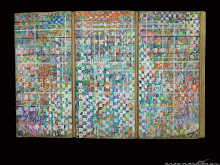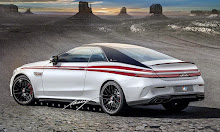"Bow Ties to the Past." self portrait, 24 x 24 inches on plywood, 2009.
As they say, whomever "they" are, lol, all good things must come to an end. Today's blogpost, casey/artandcolour's one year anniversary, is my last daily post. I'll update this blog once a month or so for the foreseeable future instead of every day.
Since I started the blog one year ago, with absolutely no idea that anyone at all would find it, it has grown far beyond any expectations or dreams I might have had. During the first full month, March 2010, the blog received 1,160 total page hits. That number fell to 765 in April, lol, but then grew steadily each month, with January 2011, the last full month, receiving 17,456 hits. I've had single days recently with twice as many hits as the entire month of April. It has been fun to compose all of these posts, and to create all of the digital art for them, and hugely gratifying to read the comments my readers have been nice enough to spend their time posting. I've made a lot of friends from around the country, (and some from around the globe.) Some days, it was truly my "regulars" that kept me going, kept me writing, and scanning, and composing the next day's post. I have all of you to thank for making this blog a cherished part of my life and not just another "project."
Next? I'm going to be working on my art and writing. I haven't finished an art piece since I started the blog. I might also have some exciting news to share by mid- or late-summer as far as my writing goes. This isn't the end of casey/artandcolour, just the end of posting every single day. I'll be updating the blog once a month as I wrote above, and I'll check in every day and keep the spam comments from used car dealers and robot-generated turbine engine part manufacturers deleted ( what a pain in the you-know-what they are!).
A huge hug, and a thank you, to everyone that clicked on my blog this past year. Onward and upward!
—Casey
• • •
I'm going to end my post today with a short essay that was published in the February 2011 issue of Hemmings Motor News. It was written by Daniel Strohl, HMN's associate editor and Hemmings Blog editor. I've received permission to publish it today, and I couldn't be more pleased. I haven't read anything in recent memory that reaches such a level of emotion in so few words. Hemmings Blog is a great way to keep up with the collector car world; they even picked up my casey/artandcolour post about the mid sixties Chrysler Turbine car. Bookmark Hemmings' Blog if you haven't already. Thank you Hemmings, and thank you Daniel! This piece just floored me. I know my readers are going to love it as well.
(Photo by Rick Hunt)
Old Oak Trees
By Daniel Strohl
Her knotted hand found his as they took the gentle slope a step at a time, crunching through the remnants of last month's snowstorm that still clung to the frozen field.
"Do you know where we're going?" she asked him. He paused, considered her for a moment through puffy, half-shut eyelids. From his permanent crouch, an old oak tree brushing the ground from which it grew, he had to turn his head to the side to look her in the eyes. Though he ran his tongue over his lips as if he were to say something, he instead shook his head slowly.
She led him on up the slope again, her own weak steps appearing strong and stable next to his slow shuffle. "We're going to see our old Lincoln," she said. "You remember our old Lincoln, don't you?" He didn't answer and simply kept his head down, tilted slightly forward. The wind, still cold and from the north, cutting through the line of trees on the ridge at the top of the slope, fluttered the white hairs that escaped from underneath his newsboy cap and lay against his wrinkled and spotted neck. She reached over with her other hand to flip his collar up, though he didn't seem to mind the wind on his bare neck.
"Our Lincoln?" he rasped out. He slowed as they came upon the white behemoth near the top of the slope, its tires embedded securely into the field, a patch of snow still clinging to the windshield.
"Yes, that's it," she said. "Bob can't keep it here any more. They're going to build houses here. So Bob wanted us to come see it again, for the...."
His grip on her hand tightened slightly, and she felt him try to straighten, though she knew that he still needed her hand. They both stood in silence by the Lincoln for a while before he ran his tongue over his lips again. He took so long to speak, she thought he'd given up.
"I remember," he finally said.
























































